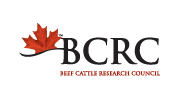Ergot: how much is too much?
| Project Code: | ANH.07.18 |
| Completed: | In Progress. Results expected in March 2022. |
Project Title:
Effect of feeding ergot alkaloids on ruminal metabolism, growth performance, health and welfare of beef cattle: How much is too much?
Researchers:
Gabriel Ribeiro (University of Calgary Faculty of Veterinary Medicine)
Kim Stanford, Tim Reuter, Mike Harding (Alberta Agriculture and Forestry); Karen Schwartzkopf-Genswein, (Agriculture and Agri-Food Canada Lethbridge); Eugene Janzen (University of Calgary); Barry Blakley (University of Saskatchewan)
Background
The risk of ergot and other mycotoxins is generally highest in years when the weather is warm and humid when grain crops and grasses are flowering. Ergot bodies contain a variety of different alkaloids that can reduce feed intake and growth, cause lameness, gangrene, abortion, weak calves, and greatly reduced milk production. Some alkaloids likely pose more danger to cattle than others. Ergot awareness and concerns are increasing among producers. Although cattle are generally believed to tolerate ergot better than pigs or chickens. But as a result of this, ergot-free feed grain may be directed to poultry or swine, potentially increasing the amount of ergot that cattle are exposed to still more.
Objectives
Understand how we can improve the rumen metabolism of ergot alkaloids, and better define maximum limits for cereal ergot alkaloids in diets of feeder cattle from a production, health, and welfare perspective. This study will also assess the ability of cattle to adapt to ergot alkaloids by comparing continuous and intermittent feeding of contaminated diets.
-
Define how much ergot and other mycotoxin contamination is there in cereal grain fed to beef cattle in Western Canada;
-
Characterize how ergot is metabolized by rumen microbes;
-
Define maximum concentrations of ergot alkaloids that can be fed without impacting beef cattle health and welfare;
-
Determine if cattle adapt to continuous doses of dietary ergot alkaloids or if tolerances to ergot are impacted by intermittent exposure
What they will do
These researchers will survey ergot alkaloid levels in Alberta and Saskatchewan and better define what levels of ergot alkaloids are safe for feedlot cattle. They will conduct an artificial rumen study to look at how ergot alkaloids and other mycotoxins are metabolized, and how they affect ruminal metabolism. They will also look at how rumen microbes respond when they’re slowly adapted to very high ergot levels (20ppm) compared to abrupt exposure to very high levels (with and without an ergot binder), compared to no ergot. A backgrounding and finishing trial will feed diets containing 0, 0.75, 1.5 and 3 ppm ergot to look at impacts on performance, physiology and welfare (and see if they adapt to ergot). A second backgrounding and finishing trial will look at the effects of continuous vs. intermittent exposure to ergot. On top of this, ergot that is simply ground up in the total mixed ration will be compared to the same level of ergot fed in pellets to assess whether the heat treatment involved in pelleting helps to reduce the dangers that ergot poses to feedlot cattle.
Implications
Understanding how to reduce the risk that ergot-contaminated feed poses to cattle is critical to maintain animal health and welfare and avoid feed waste.






